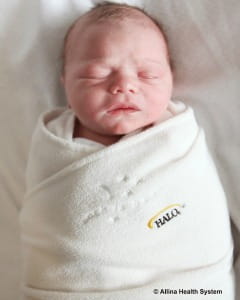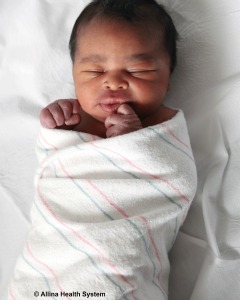
Reducing the risk of sudden infant death syndrome (SIDS)
Sudden infant death syndrome (SIDS) is the sudden and unexplainable death of a baby younger than 12 months old. These babies appear to be healthy yet die when they are asleep.
Most SIDS deaths occur when babies are one to four months old. The peak time is two to three months old. SIDS is not common. It happens to fewer than one in 1,000 babies in this country.

A sleep sack is the safest way for your baby to sleep "arms in or arms out."

You may also use a blanket to swaddle. Stop swaddling your baby when they look like they are trying to roll over.
To help prevent your baby's head from getting a little flatter on one side or in the back, give your baby lots of tummy time when they are awake. Each week, switch the direction your baby faces in the crib.
There are things you can do to reduce your baby's risk of SIDS. The American Academy of Pediatrics (AAP) recommends the following:
- Your baby is safest sleeping on their back. Always place your baby on their back to sleep.
- Use a firm crib mattress covered with only a fitted sheet.
- Never have your baby sleep on a pillow, sheepskin, fluffy bedding or water bed. Never use a couch, sofa, chair, inclined sleeper or infant sleep positioner as a place for your baby to sleep.
- Keep soft, loose bedding and toys out of the crib. Don't place pillows, quilts or stuffed animals in the crib. Don't use bumper pads.
- Don't let your baby get overheated. Keep the room temperature comfortable for an adult.
- The safest place for your baby to sleep is in your room in a crib or bassinet (not in the same bed).
- The AAP recommends sharing a bedroom for at least the first 6 months, or preferably until your baby turns 1.
- Co-sleeping (sleeping in the same bed with your baby) is not recommended.
- Don’t let your baby sleep with a sibling.
- You should only bring your baby into your bed to feed or comfort. When you are done, put your baby back into their crib or bassinet. If there is a chance you will fall asleep, make sure there are no items in your bed that could cover your baby (such as pillows, sheets, blankets). Move your baby back to their crib as soon as you wake up.
- Consider offering your baby a clean, dry pacifier at naptime and bedtime. Don't force your baby to take it. If you are breastfeeding, don't offer the pacifier until breastfeeding is well established. This may be at about one month of age.
- Don't allow anyone to smoke around your baby.
- Don't use commercial devices or baby monitors that claim to reduce the risk of SIDS. There is no evidence such products reduce the incidence of SIDS.
If you use these products, they are OK for listening to your baby when you are in different rooms, but they don't prevent SIDS accidents.
Talk with your baby's health care provider about what is best for your baby if your baby often spits up after eating or has breathing, heart or lung problems.